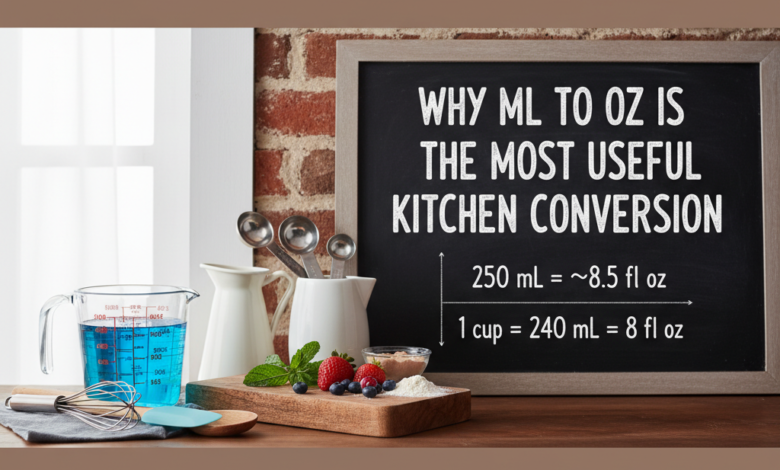Why mL to oz Is the Most Useful Kitchen Conversion

In both education and everyday life, few conversions are as practical and frequently used as mL to oz the conversion between milliliters and fluid ounces. Whether you’re a student solving chemistry problems or a home chef perfecting recipes, understanding this relationship helps bridge the gap between the metric system and imperial units.
Liquid measurements are universal. Yet, depending on where you live, recipes, lab manuals, or packaging may use different units. This makes knowing how to convert milliliters (mL) to ounces (oz) an essential skill that saves time, improves accuracy, and eliminates guesswork.
Let’s explore why this conversion is so valuable, how to calculate it easily, and why it’s one of the most practical measurements across multiple fields.
What Are Milliliters and Ounces?
Before we get into the formula, it’s helpful to clarify what these units represent.
- Milliliter (mL): A unit of volume in the metric system, often used worldwide for liquid measurement.
1 milliliter = 1 cubic centimeter (1 mL = 1 cm³). - Fluid Ounce (oz): A unit of volume used in the imperial and US customary systems. It measures the same concept of liquid volume but with a different scale.
This difference in systems creates the need for conversions, especially in fields like:
- Cooking and Baking (e.g., converting 250 mL of milk to ounces for a U.S. recipe)
- Science and Education (e.g., lab experiments requiring precise liquid measurements)
- Health and Nutrition (e.g., understanding fluid intake or medication dosage)
- Manufacturing and Engineering (e.g., converting production quantities or fluid volumes in industrial settings)
The mL to oz Conversion Formula
The conversion between milliliters and ounces depends slightly on whether you’re using U.S. fluid ounces or U.K. (Imperial) fluid ounces.
Formula for U.S. Fluid Ounces
1 U.S. fluid ounce = 29.5735 milliliters
To convert mL to oz (U.S.):
oz = mL ÷ 29.5735
Formula for U.K. (Imperial) Fluid Ounces
1 U.K. fluid ounce = 28.4131 milliliters
To convert mL to oz (U.K.):
oz = mL ÷ 28.4131
Example Calculations
| Milliliters (mL) | U.S. Fluid Ounces (oz) | U.K. Fluid Ounces (oz) |
| 100 mL | 3.38 oz | 3.52 oz |
| 250 mL | 8.45 oz | 8.80 oz |
| 500 mL | 16.91 oz | 17.60 oz |
| 1000 mL | 33.81 oz | 35.20 oz |
These conversions make it easy to adapt any recipe, experiment, or project that uses different measurement systems.
See also: Reducing Sales Team Stress Through Automated RFP Responses
How to Convert mL to oz Step-by-Step Guide
Let’s go through a simple example to show how this conversion works in real-world scenarios.
Example: Convert 750 mL to ounces (U.S. fluid ounces)
Step 1: Write the formula
oz = mL ÷ 29.5735
Step 2: Substitute the value
oz = 750 ÷ 29.5735
Step 3: Calculate
oz = 25.36
So, 750 mL = 25.36 oz (U.S.)
You can apply this same method to any volume value. Alternatively, you can use an online mL to oz converter to get instant results perfect for quick calculations in the classroom, kitchen, or lab.
Why mL to oz Is the Most Useful Conversion
It Connects Two Global Measurement Systems
The metric and imperial systems coexist across the world and this conversion bridges them. A student in Europe can understand a recipe from the U.S., or a scientist in the U.K. can compare data from an American research paper.
Essential in Everyday Cooking and Baking
Recipes often switch between milliliters and ounces depending on origin. Knowing this conversion ensures consistent results, especially for liquids like milk, oil, or water.
Example:
A U.S. recipe might call for 12 oz of milk. To prepare it accurately using metric tools:
mL = 12 × 29.5735 = 354.88 mL
Critical in Science and Education
Students and teachers often deal with both systems in lab experiments, especially when analyzing international data. The mL to oz conversion reinforces unit consistency and improves precision in reporting.
Useful in Health and Fitness
Water intake, nutrition labels, and supplements frequently use both mL and oz. Understanding the conversion helps track hydration or dosage accurately.
Example:
A sports bottle labeled 500 mL contains approximately 16.91 oz of liquid.
Helpful in Manufacturing and Global Trade
In industries like pharmaceuticals, beverages, and cosmetics, measurements must often be converted for global compliance and labeling. mL to oz conversion ensures accurate packaging and consistent communication across markets.
Quick Reference Conversion Table
| mL | oz (U.S.) | oz (U.K.) |
| 10 | 0.34 | 0.35 |
| 50 | 1.69 | 1.76 |
| 100 | 3.38 | 3.52 |
| 250 | 8.45 | 8.80 |
| 500 | 16.91 | 17.60 |
| 750 | 25.36 | 26.40 |
| 1000 | 33.81 | 35.20 |
This quick guide helps you convert instantly without needing a calculator — ideal for both kitchen counters and classroom labs.
Common Mistakes to Avoid
Even though the conversion seems simple, it’s easy to make small errors that lead to inaccurate results. Here are some quick tips to avoid them:
- Check the system — always confirm if the recipe or formula uses U.S. or U.K. ounces.
- Avoid rounding too early — keep 2–3 decimal places for more precision.
- Be consistent — don’t mix units within the same calculation or experiment.
Practical Uses Across Fields
| Field | Example of Conversion Use |
| Education | Converting liquid volumes in chemistry experiments |
| Cooking | Adjusting recipes from U.S. (oz) to metric (mL) measurements |
| Nutrition | Calculating daily water intake or supplement dosage |
| Manufacturing | Labeling bottles accurately for global markets |
| Health | Measuring medications or fluid requirements precisely |
Conclusion:
From school labs to home kitchens, the mL to oz conversion is one of the most versatile and valuable measurement skills. It connects two major systems of units, ensures precision, and simplifies every task involving liquid measurements.
For effortless, accurate conversions, use DigiCalc mL to oz calculator. Our tool provides instant, reliable, and precise results, helping you save time and eliminate errors in any context.





